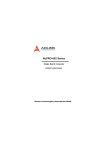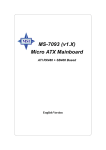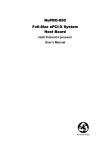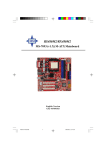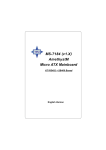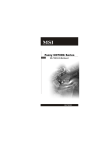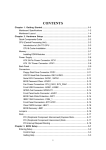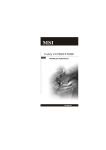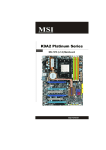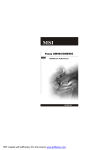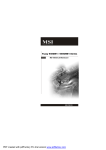Download MSI Super Q963 User`s manual
Transcript
Super Q965/Q963 MS-9643 (V1.X) Mainboard G52-96431X5 i Copyright Notice Th e material in this d ocument is the in tellectual p rop erty of MICRO-STAR INTERNATIONAL. We take every care in the preparation of this document, but no guarantee is given as to the correctness of its contents. Our products are under continual improvement and we reserve the right to make changes without notice. Trademarks All trademarks are the properties of their respective owners. Intel® and Pentium® are registered trademarks of Intel Corporation. AMD, Athlon™, Athlon™ XP, Thoroughbred™, and Duron™ are registered trademarks of AMD Corporation. NVIDIA, the NVIDIA logo, DualNet, and nForce are registered trademarks or trademarks of NVIDIA Corporation in the United States and/or other countries. PS/2 and OS ®/2 are registered trademarks of International Business Machines Corporation. Windows® 95/98/2000/NT/XP are registered trademarks of Microsoft Corporation. Netware® is a registered trademark of Novell, Inc. Award® is a registered trademark of Phoenix Technologies Ltd. AMI® is a registered trademark of American Megatrends Inc. Revision History Revision V1.3 Revision History Upgrading audio Date June 2007 Technical Support If a problem arises with your system and no solution can be obtained from the user’s manual, please contact your place of purchase or local distributor. Alternatively, please try the following help resources for further guidance. Visit th e MSI web site at http://global.msi.com.tw/index.php? func=faqIndex for FAQ, technical guide, BIOS updates, driver updates, and other information. Contact our technical staff at http://support.msi.com.tw/. ii Safety Instructions 1. Always read the safety instructions carefully. 2. Keep this User’s Manual for future reference. 3. Keep this equipment away from humidity. 4. Lay this equipment on a reliable flat surface before setting it up. 5. The openings on the enclosure are for air convection hence protects the equipment from overheating. DO NOT COVER THE OPENINGS. 6. Make sure the voltage of the power source and adjust properly 110/220V before connecting the equipment to the power inlet. 7. Place the power cord such a way that people can not step on it. Do not place anything over the power cord. 8. Always Unplug the Power Cord before inserting any add-on card or module. 9. All cautions and warnings on the equipment should be noted. 10. Never pour any liquid into the opening that could damage or cause electrical shock. 11. If any of the following situations arises, get the equipment checked by service personnel: † The power cord or plug is damaged. † Liquid has penetrated into the equipment. † The equipment has been exposed to moisture. † The equipment does not work well or you can not get it work according to User’s Manual. † The equipment has dropped and damaged. † The equipment has obvious sign of breakage. 12. DO NOT LEAVE THIS EQUIPMENT IN AN ENVIRONMENT UNCONDITIONED, STORAGE TEMPERATURE ABOVE 600 C (1400F), IT MAY DAMAGE THE EQUIPMENT. CAUTION: Dan g er of exp losion if b attery is in correctl y rep laced . Replace on ly with the same or equivalent type recommen ded by the manufacturer. iii Warranty Policy Thank you for choosing MSI. To understand your rights and enjoy all the after-sales services we offer, please read the following carefully: 1. Before using MSI products please read the user’s manual and follow the instructions exactly. 2. When sending in damaged products for repair, please attach an RMA application form. 3. All MSI products come with a two-year guarantee for free-of-charge repair. n The warranty period starts from the product’s shipment date from MSI’s factory. n Peripherals and third-party products not manufactured by MSI will be covered by the original manufacturers’ warranty. n End users requiring maintenance services should contact their local dealers. Local warranty conditions will depend on local dealers. 4. This warranty will not cover repair costs due to: a. Damage caused by not following instructions. b. Damage caused by carelessness on the users’ part during product transportation. c. Damage caused by fire, earthquakes, floods, lightening, pollution, other acts of God, and/or incorrect usage of voltage transformers. d. Damage cau sed by un suitabl e storage environ men ts (i.e. h ig h temperatures, high humidity, or volatile chemicals.) e. Damage caused by leakage of battery fluid. f. Damage from improper repair by unauthorized technicians. g. Products with altered and/or damaged serial numbers. h. Other categories not protected under our guarantees. 5. Customers are responsible for shipping costs to transport damaged products to our company or sales office. 6. To ensure the speed and quality of product repair, please download an RMA application form from our company website http://www.msi.com.tw. Damaged products with attached RMA forms receive priority. For further questions, please contact our FAE staff at http://support.msi.com.tw/. iv FCC-B Radio Frequency Interference Statement Th is eq u ip men t h as been tested and found to comply with the limits for a Class B digital device, pursuant to Part 15 of the FCC Rules. These limits are designed to provide reasonable protection against harmful interference in a residential installation. This equipment generates, uses and can radiate radio frequency energy and, if not installed and used in accordance with the instructions, may cause harmful interference to radio communications. However, there is no guarantee that interference will not occur in a particular installation. If this equipment does cause harmful interference to radio or television reception, which can be determined by turning the equipment off and on, the user is encouraged to try to correct the interference by one or more of the measures listed bel ow. † Reorient or relocate the receiving antenna. † Increase the separation between the equipment and receiver. † Connect the equipment into an outlet on a circuit different from that to which the receiver is connected. † Consult the dealer or an experienced radio/television technician for help. Notice 1 The changes or modifications not expressly approved by the party responsible for compliance could void the user’s authority to operate the equipment. Notice 2 Shielded interface cables and A.C. power cord, if any, must be used in order to comply with the emission limits. VOIR LA NOTICE D’INSTALLATION AVANT DE RACCORDER AU RESEAU. Micro-Star International MS-9643 This device complies with Part 15 of the FCC Rules. Operation is subject to the following two conditions: (1) this device may not cause harmful interference, and (2) this device must accept any interference received, including interference that may cause undesired operation. v WEEE (Waste Electrical and Electronic Equipment) Statement vi vii viii CONTENTS Copyright Notice ..................................................................................................... ii Trademarks ............................................................................................................. ii Revision History ..................................................................................................... ii Technical Support .................................................................................................. ii Safety Instructions ............................................................................................... iii Warranty Policy .................................................................................................... iv FCC-B Radio Frequency Interference Statement .................................................... v WEEE (Waste Electrical and Electronic Equipment) Statement ............................... vi Chapter 1 Getting Started .............................................................................. 1-1 Mainboard Specifications ............................................................................ 1-2 Mainboard Layout ........................................................................................ 1-4 Chapter 2 Hardware Setup ............................................................................. 2-1 Quick Components Guide ............................................................................. 2-2 CPU (Central Processing Unit) ...................................................................... 2-3 Introduction to LGA 775 CPU ................................................................ 2-3 CPU Installation ..................................................................................... 2-4 Cooler Installation ................................................................................. 2-5 Memory ....................................................................................................... 2-6 Installing DDRII Modules ........................................................................ 2-6 Power Supply .............................................................................................. 2-7 ATX 12V Power Connector: JPW1 ........................................................ 2-7 Bracket I/O ................................................................................................... 2-8 Connectors .................................................................................................. 2-9 Temperature Sensor Connector: JRT1 .................................................. 2-9 ATA133 Hard Disk Connector: IDE1 ....................................................... 2-9 Serial ATA Connectors: SATA1, SATA2 ............................................... 2-10 Fan Power Connector: CPU_FAN1 ...................................................... 2-11 Serial Port Connectors: COM1, COM 2 ................................................ 2-11 Front Panel Connector: JFP1 .............................................................. 2-12 Front Audio Connector: JAUD1 ........................................................... 2-13 Front USB Connectors: F_USB1, F_USB2 .......................................... 2-14 Parallel Port Header: J1 ...................................................................... 2-15 Jumpers .................................................................................................... 2-17 Clear BIOS Password Jumper: JPWD1 ................................................ 2-16 Clear CMOS Jumper: JBAT1 ............................................................... 2-16 COM1 Jumpers: JP1, JP2, JP3 ............................................................. 2-17 ix Golden Finger ............................................................................................ 2-18 PCI/ISA Golden Finger ......................................................................... 2-18 Chapter 3 BIOS Setup ...................................................................................... 3-1 Entering Setup ............................................................................................. 3-2 Control Keys ......................................................................................... 3-3 Getting Help .......................................................................................... 3-3 General Help <F1> ................................................................................ 3-3 The Menu Bar .............................................................................................. 3-4 Main ............................................................................................................. 3-5 Advanced .................................................................................................... 3-7 Boot ........................................................................................................... 3-20 Security ..................................................................................................... 3-21 System ...................................................................................................... 3-23 PC Health ................................................................................................... 3-25 Exit ............................................................................................................ 3-25 x Getting Started Chapter 1 Getting Started Thank you for choosing the MS-9643 PCI/ISA Single Board Computer from MSI. Based on the innovative Intel® Q965/Q963 & ICH8 controllers for optimal system efficiency, the MS-9643 accommodates the latest Intel® CoreTM 2 Duo/Pentium® 4/Pentium® D/Celeron ® D processors in LGA775 socket and supports two 240-pin 800 (Q965 only)/667/ 533MHz DDR2 DIMM slots to provide the maximum of 2GB memory capacity. This PCI/ISA SBC is more maintainable than a conventional motherboard system and has a much lower mean time to repair (MTTR). It’s easily upgradeable and provides configuration control for longer product lifetime. 1-1 MS-9643 Mainboard Mainboard Specifications Processor Support - Intel® Core TM 2 Duo/Pentium® 4/Pentium® D/Celeron® D processors in Socket LGA775 - Supports 4-pin CPU fan pinheader - Supports Intel Dual Core TM Technology Supported FSB - 1066/ 800/ 533 MHz Chipset - North Bridge: Intel® Q965/Q963 chipset - South Bridge: Intel® ICH8 chipset Memory Support - 2 DDR2 800 (Q965 only)/667/533 DIMM slots (240 pins/1.8V) - 2 GB memory capacity LAN - 1 or 2 PCIE x1 Gb LAN by Marvell 88E8056 (optional) Audio (optional) - Realtek® ALC888 codec - 1 front audio pinheader IDE - 1 ATA133 IDE port by JMicron® JMB361 SATA - 2 SATA II ports by ICH8 - Supports 2 SATA II devices - Supports storage and data transfers at up to 300 MB/s ISA Bridge - ITE IT8888G-L 1-2 Getting Started Connectors Bracket I/O - 1 PS/2 mouse/keyboard port - 1 or 2 Gb LAN ports (optional) - 1 VGA port Onboard Pinheaders - 1 front panel pinheader - 1 front audio pinheader - 2 universal serial ports (COM2 supports RS232; COM1 supports RS232, RS422, RS485) - 2 USB 2.0 pinheaders - 1 IDE connector - 1 parallel port pinheader - 2 SATA connectors Golden Finger - Supports ISA & PCI Form Factor - SBC (Single Board Computer): 12.3cm x 33.9cm Environmental Specs - Operating Temperature: 0 oC ~ +50 o C 1-3 MS-9643 Mainboard Mainboard Layout MS-9643 (v1.X) Single Board Computer 1-4 Hardware Setup Chapter 2 Hardware Setup This chapter provides you with the information about hardware setup procedures. While doing the installation, be careful in holding the components and follow the installation procedures. For some components, if you install in the wrong orientation, the components will not work properly. Use a grounded wrist strap before handling computer comp onen ts. Static el ectricity may damag e th e components. 2-1 MS-9643 Mainboard Quick Components Guide IDE1, p.2-9 Bracket I/O, p.2-8 C OM 1 /2 , p.2-11 J1, p.2-15 JAUD1, p.2-13 (optional) JRT1, p.2-9 F_USB1/2, p.2-14 SATA1/2, p.2-10 JBAT1, p.2-16 JPWD1, p.2-16 JP1/2/3, p.2-17 DIMM Slots, p.2-6 CPU_FAN1, p.2-11 JFP1, p.2-12 CPU, p.2-3 JPW1, p.2-7 2-2 Hardware Setup CPU (Central Processing Unit) This mainboard supports Intel® CoreTM 2 Duo/Pentium® 4/Pentium® D/Celeron® D processors in LGA 775 package. When you are installing the CPU, make sure that you install the cooler to prevent the CPU from overheating. If you do not have a CPU cooler, contact your dealer to purchase and install it before turning on the computer. Important 1. Overheating will seriously damage the CPU and system. Always make sure the cooling fan can work properly to protect the CPU from overheating. 2. Make sure that you apply an even layer of heat sink paste (or thermal tape) between the CPU and the heatsink to enhance heat dissipation. 3. While replacing the CPU, always turn off the power supply or unplug the power supply’s power cord from the grounded outlet first to ensure the safety of CPU. Introduction to LGA 775 CPU The pin -pad side of LGA 775 CPU. Alignment Key Yellow triangle is the Pin 1 indicator The surface of LGA 775 CPU. Remember to apply some silicone heat transfer compound on it for better heat dispersion. Alignment Key Yellow triangle is the Pin 1 indicator 2-3 MS-9643 Mainboard CPU Installation When integrating a Pentium 4 processor-based system, be sure to take the proper electrostatic discharge (ESD) precautions. Consider using ground straps, gloves, ED mats, or other protective measures to avoid damaging the processor and other electrical components in the system. Do not touch socket sensitive contacts. W e assume no responsibility for the potential damages caused by this action and therefore the warranty we provide may be invalid. Note: In order to boot up with a newly installed CPU, AC Power must be switched off before installation. n n n n n 2-4 Disengage Load Lever by depressing down and out on the hook to clear retention tab. Rotate Load Lever to fully open position at approximately 135° Rotate Load Plate to fully open position at approximately 100°. Remove Socket Protective Cover. With left hand index finger and thumb to support the load plate edge, engage protective cover finger tab with right hand thumb and peel the cover from LGA775 Socket while pressing on center of protective cover to assist in removal. Locate two orientation key notches. Grape processor with thumb and index finger. (Grasp the edges without the orientation notches.) The socket has cutouts for your fingers to fit into. Carefully pace the package into the socket body using a purely vertical motion. (Tilting the processor into place or shifting it into place on the socket can damage the sensitive socket contacts.) Verify that package is within the socket body and properly mated to the orientation keys Hardware Setup n Close the socket by 1. Close the Load Plate 2. While pressing down lightly on Load Plate, engage the Load Lever. 3. Secure Load Lever with Load Plate tab under retention tab of Load Lever. Cooler Installation This processor has to fit a special cooling fan. When the processor runs, it will increase the internal ambient temperature. A chassis with a maximum internal ambient temperature of 38oC at the processor fan inlet is a requirement. Failure to provide this could result in damage to the board. Please make sure the cooler has been recommended by Intel. For more details, go to http://www.intel.com. Smear thermal grease on the top of the CPU. Lower the CPU fan onto the CPU and socket, and secure it using the attachments or screws provided on the fan. Finally, attach the fan power cable to the CPU FAN adapter. Warning! Please make sure that you use a CPU cooler bundled with a retention module to keep PCB from crookedness. A crooked SBC may probably result in unknown problem. 2-5 MS-9643 Mainboard Memory The mainboard provides two 240-pin non-ECC Dual-Channel DDR2 800 (for Q965 only) / 667 / 533 DIMM slots and supports up to 2GB system memory. DDR2 240-pin, 1.8V 64x2=128 pin 56x2=112 pin Installing DDR2 Modules 1. The memory module has only one notch on the center and will only fit in the right orientation. 2. Insert the memory module vertically into the DIMM slot. Then push it in until the golden finger on the memory module is deeply inserted in the DIMM slot. Important You can barely see the golden finger if the memory module is properly inserted in the DIMM slot. 3. The plastic clip at each side of the DIMM slot will automatically close. Volt 2-6 Notch Hardware Setup Power Supply ATX 12V Power Connector: JPW1 This 12V power connector is used to provide power to the CPU. 3 4 1 2 JPW1 JPW 1 Pin Definition PIN SIGNAL 1 2 3 4 GND GND 12V 12V 2-7 MS-9643 Mainboard Bracket I/O Mouse/ Keyboard VGA Port LAN1 LAN2 (Optional) (Optional) Mouse/Keyboard Connector The standard PS/2® mouse/keyboard DIN connector is for a PS/2® mouse/keyboard. VGA Connector The DB15-pin female connector is provided for VGA monitors. LAN (RJ-45) Jack The standard RJ-45 jack is for connection to single Local Area Network (LAN). You can connect a network cable to it. LED Color LED State Off Left Yellow On (steady state) Activity Indicator Link Indicator Condition LAN link is not established. LAN link is established. On (brighter & pulsing) The computer is communicating with another computer on the LAN. Green Right Yellow 2-8 Off 10 Mbit/sec data rate is selected. On 100 Mbit/sec data rate is selected. On 1000 Mbit/sec data rate is selected. Hardware Setup Connectors Temperature Sensor Connector: JRT1 This connector is used to connect an external temperature sensor. ATA133 Hard Disk Connector: IDE1 The mainboard has a 32-bit Enhanced PCI IDE and Ultra DMA 66/100/133 controller that provides PIO mode 0~4, Bus Master, and Ultra DMA 66/100/133 function. You can connect hard disk drives, CD-ROM and other IDE devices. IDE1 Important If you install two IDE devices on the same cable, you must configure the drives separately to master / slave mode by setting jumpers. Refer to IDE device’s documentation supplied by the vendors for jumper setting instructions. 2-9 MS-9643 Mainboard Serial ATA Connector: SATA1, SATA2 SATA1~SATA2 are high-speed SATA II interface ports and support SATA II data rates of 300MB/s. Each SATA II connector can connect to 1 hard disk device and is fully compliant with Serial ATA 2.0 specifications. SATA2 SATA1 Important Please do not fold the Serial ATA cable into 90-degree angle. Otherwise, data loss may occur during transmission. 2-10 Hardware Setup Fan Power Connector: CPU_FAN1 The fan power connector supports system cooling fan with +12V. When connecting the wire to the connectors, always take note that the red wire is the positive and should be connected to the +12V, the black wire is Ground and should be connected to GND. If the mainboard has a System Hardware Monitor chipset on-board, you must use a specially designed fan with speed sensor to take advantage of the CPU fan control. CONTROL SENSOR +1 2V GND CPU_FAN1 Important Please refer to the recommended CPU fans at Intel® official website or consult the vendors for proper CPU cooling fan. Serial Port Connectors: COM1, COM 2 The mainboard provides 9-pin headers as RS232/422/485 COM ports to connect serial devices. 9 10 1 2 COM1/2 Pin Definition PIN 1 2 3 4 5 6 7 8 9 SIGNAL DESCRIPTION DCD SIN SOUT DTR GND DSR RTS CTS RI Data Carry Detect Serial In or Receive Data Serial Out or Transmit Data Data Terminal Ready Ground Data Set Ready Request To Send Clear To Send Ring Indicate 2-11 MS-9643 Mainboard Front Panel Connector: JFP1 The mainboard provides one front panel connector for electrical connection to the front panel switches and LEDs. Chassis Reset HDD Power On Speaker Button LED Button JFP1 2 1 20 19 Power LED ATX Power JFP1 Pin Definition 2-12 PIN SIGNAL FUNCTION 1 3 5 7 9 11 13 15 17 19 2 4 6 8 10 12 14 16 18 +5V NC PLED NC GND GND NC PWRON +5VSB NC WDSPK NC NC +5V RESETBT GND HDDLED +5V +5VSB Power No Connection Power LED Signal No Connection Ground Ground No Connection Power-On Signal StandbyPower No Connection Speaker Signal No Connection No Connection Power Reset Button Signal Ground Hard Disk LED Signal Power StandbyPower 20 PWRBT Power Button Signal PIN GROUP Power LED ATXPower Chassis Speaker Reset Button Hard Disk LED Power On Button Hardware Setup Front Audio Connector: JAUD1 (optional) The JAUD1 is used to connect an optional audio bracket that provides extra front panel audio IO jacks. JAUD1 13 14 1 2 JAUD1 Pin Definition PIN SIGNAL PIN SIGNAL 1 LINE_IN_R 2 MIC_IN_R 3 5 7 9 11 13 LINE_IN_L LINE_OUT_R LINE_OUT_L LINE_OUT_JD GND NC 4 6 8 10 12 14 MIC_IN_L MIC_IN_JD LINE_IN_JD GND GND GND 2-13 MS-9643 Mainboard Front USB Connectors: F_USB1, F_USB2 The mainboard provides two USB 2.0 pinheaders (optional USB 2.0 bracket available) that are compliant with Intel® I/O Connectivity Design Guide. USB 2.0 technology increases data transfer rate up to a maximum throughput of 480Mbps, which is 40 times faster than USB 1.1, and is ideal for connecting high-speed USB interface peripherals such as USB HDD, digital cameras, MP3 players, printers, modems and the like. F_USB1/2 1 2 9 10 Pin Definition PIN SIGNAL PIN SIGNAL 1 VCC 2 VCC 3 USB0- 4 USB1- 5 USB0+ 6 USB1+ 7 GND 8 GND 9 Key (no pin) 10 USBOC USB 2.0 Bracket (Optional) Important Note that the pins of VCC and GND must be connected correctly to avoid possible damage. 2-14 Hardware Setup Parallel Port Header: J1 The mainboard provides a 26-pin header for connection to an optional parallel port bracket. The parallel port is a standard printer port that supports Enhanced Parallel Port (EPP) and Extended Capabilities Parallel Port (ECP) mode. J1 14 1 26 13 Pin Definition PIN SIGNAL DESCRIPTION 1 2 3 4 5 6 7 8 9 10 11 12 13 14 15 16 17 18 19 20 21 22 23 24 25 STROBE DATA0 DATA1 DATA2 DATA3 DATA4 DATA5 DATA6 DATA7 ACK# BUSY PE SELECT AUTO FEED# ERR# INIT# SLIN# GND GND GND GND GND GND GND GND Strobe Data0 Data1 Data2 Data3 Data4 Data5 Data6 Data7 Acknowledge Busy Paper End Select Automatic Feed Error Initialize Printer Select In Ground Ground Ground Ground Ground Ground Ground Ground 2-15 MS-9643 Mainboard Jumpers Clear BIOS Password Jumper: JPWD1 The jumper is used to clear the BIOS password. You can clear BIOS password by shorting this jumper with a jumper cap while the system is off. Then restart the system. Be sure to remove the jumper cap to return to normal operation on next boot. Avoid clearing the password while the system is on; it will damage the mainboard. JPWD1 Clear Normal Clear CMOS Jumper: JBAT1 There is a CMOS RAM onboard that has a power supply from external battery to keep the data of system configuration. With the CMOS RAM, the system can automatically boot OS every time it is turned on. If you want to clear the system configuration, set the JBAT1 (Clear CMOS Jumper ) to clear data. JBAT1 3 1 3 1 1 Keep Data Clear Data Important You can clear CMOS by shorting 2-3 pin while the system is off. Then return to 1-2 pin position. Avoid clearing the CMOS while the system is on; it will damage the mainboard. 2-16 Hardware Setup COM1 Jumpers: JP1, JP2, JP3 These jumpers specify the COM1 function. JP3 JP2 JP1 6 5 6 5 6 5 2 1 2 1 2 1 RS-232 (JP3: 1-2 JP2: 1-3, 2-4 JP1: 1-3, 2-4) JP3 JP2 JP1 RS-422 (JP3: 3-4 JP2: 3-5, 4-6 JP1: 3-5, 4-6) JP3 JP2 JP1 RS-485 (JP3: 5-6 JP2: 3-5, 4-6 JP1: 3-5, 4-6) JP3 JP2 JP1 2-17 MS-9643 Mainboard Golden Finger PCI/ISA Golden Finger This PCI/ISA SBC board has two edge connectors on it - one for the PCI bus and one for the ISA bus. PCI/ISA Golden Finger 2-18 BIOS Setup Chapter 3 BIOS Setup This chapter provides information on the BIOS Setup program and allows you to configure the system for optimum use. You may need to run the Setup program when: ² An error message appears on the screen during the system booting up, and requests you to run SETUP. ² You want to change the default settings for customized features. 3-1 MS-9643 Mainboard Entering Setup Power on the computer and the system will start POST (Power On Self Test) process. When the message below appears on the screen, press <F1> key to enter Setup. Press F1 to enter SETUP If the message disappears before you respond and you still wish to enter Setup, restart the system by turning it OFF and On or pressing the RESET button. You may also restart the system by simultaneously pressing <Ctrl>, <Alt>, and <Delete> keys. Important 1. The items under each BIOS category described in this chapter are under continuous update for better system performance. Therefore, the description may be slightly different from the latest BIOS and should be held for reference only. 2. Upon boot-up, the 1st line appearing after the memory count is the BIOS version. It is usually in the format: P9643IMS V1.0 091506 where: 1st digit refers to BIOS maker as A = AMI, W = AWARD, and P = PHOENIX. 2nd - 5th digit refers to the model number. 6th digit refers to the chipset as I = Intel, N = nVidia, and V = VIA. 7th - 8th digit refers to the customer as MS = all standard customers. V1.0 refers to the BIOS version. 091506 refers to the date this BIOS was released. 3-2 BIOS Setup Control Keys <↑> <↓> <←> <→> <Enter> <Esc> <+/PU> <-/PD> <F6> <F7> <F10> Move to the previous item Move to the next item Move to the item in the left hand Move to the item in the right hand Select the item Jumps to the Exit menu or returns to the main menu from a submenu Increase the numeric value or make changes Decrease the numeric value or make changes Load Optimized Defaults Load Fail-Safe Defaults Save all the CMOS changes and exit Getting Help After entering the Setup menu, the first menu you will see is the Main Menu. Main Menu The main menu lists the setup functions you can make changes to. You can use the arrow keys ( ↑↓ ) to select the item. The on-line description of the highlighted setup function is displayed at the bottom of the screen. Sub-Menu If you find a right pointer symbol (as shown in the right view) appears to the left of certain fields that means a sub-menu can be launched from this field. A sub-menu contains additional options for a field parameter. You can use arrow keys ( ↑↓ ) to highlight the field and press <Enter> to call up the sub-menu. Then you can use the control keys to enter values and move from field to field within a submenu. If you want to return to the main menu, just press the <Esc >. General Help <F1> The BIOS setup program provides a General Help screen. You can call up this screen from any menu by simply pressing <F1>. The Help screen lists the appropriate keys to use and the possible selections for the highlighted item. Press <Esc> to exit the Help screen. 3-3 MS-9643 Mainboard The Menu Bar Main Use this menu for basic system configurations, such as time, date etc. Advanced Use this menu to set up the items of special enhanced features available on your system’s chipset. Boot Use this menu to specify the priority of boot devices. Security Use this menu to set Supervisor and User Passwords. System This entry shows your system summary. PC Health This entry monitors your hardware health status. Exit This menu allows you to load the BIOS default values or factory default settings into the BIOS and exit the BIOS setup utility with or without changes. 3-4 BIOS Setup Main Date (mm:dd:yy) The date format is <Day>, <Month> <Date> <Year>. Time (hh:mm:ss) The time format is <Hour> <Minute> <Second>. IDE Channel 0/1 Master, IDE Channel 2 Master/Slave [Type] Press PgUp/<+> or PgDn/<-> to select [Manual], [None] or [Auto] type. Note that the specifications of your drive must match with the drive table. The hard disk will not work properly if you enter improper information for this category. If your hard disk drive type is not matched or listed, you can use [Manual] to define your own drive type manually. [Multi-Sector Transfers] Any selection except Disabled determines the number of sectors transferred per block [LBA Mode Control] Enabling LBA causes Logical Block Addressing to be used in place of Cylinders, Heads and Sectors [32-Bit I/O] Enables 32-bit communication between CPU and IDE card 3-5 MS-9643 Mainboard [Tranfer Mode] [Ultra DMA Mode] Selects the method for transferring the data between the hard disk and system memory Indicates the type of Ultra DMA Base/Extended/Total Memory The three items show the memory status of the system. (Read-only) 3-6 BIOS Setup Advanced Advanced BIOS Features 3-7 MS-9643 Mainboard CPU Feature Thermal Management This setting specifies the thermal technologies implemented in the Pentium M processor. TM2 Bus Ratio / TM2 Bus VID These settings specify the multiplier and VID values used by the processor in TM2 (Thermal Monitor 2) mode. Limit CPUID MaxVal This setting controls the Max CPUID extended function value. C1E Function This item allows you to enable/disable the C1E power management feature which can drop clock speed and voltage on the processor. Execute Disable Bit Intel's Execute Disable Bit functionality can prevent certain classes of malicious "buffer overflow" attacks when combined with a supporting operating system. This functionality allows the processor to classify areas in memory by where application code can execute and where it cannot. When a malicious worm attempts to insert code in the buffer, the processor disables code execution, preventing damage or worm propagation. Virus Warning The item is to set the Virus Warning feature for IDE Hard Disk boot sector protection. If the function is enabled and any attempt to write data into this area is made, BIOS will display a warning message on screen and beep. 3-8 BIOS Setup Quick Power On Self Test Select [Enabled] to reduce the amount of time required to run the power-on selftest (POST). A quick POST skips certain steps. We recommend that you normally disable quick POST. Better to find a problem during POST than lose data during your work. Boot Up NumLock Status This setting is to set the Num Lock status when the system is powered on. Setting to [On] will turn on the Num Lock key when the system is powered on. Setting to [Off] will allow users to use the arrow keys on the numeric keypad. Gate A20 Option This item is to set the Gate A20 status. A20 refers to the first 64KB of extended memory. When the default value [Fast] is selected, the Gate A20 is controlled by Port92 or chipset specific method resulting in faster system performance. When [Normal] is selected, A20 is controlled by a keyboard controller or chipset hardware. Typematic Rate Setting This item is used to enable or disable the typematic rate setting including Typematic Rate & Typematic Delay. Typematic Rate (Chars/Sec) After Typematic Rate Setting is enabled, this item allows you to set the rate (characters/second) at which the keys are accelerated. Typematic Delay (Msec) This item allows you to select the delay between when the key was first pressed and when the acceleration begins. Security Option This specifies the type of BIOS password protection that is implemented. Settings are described below: Option [Setup] Description The password prompt appears only when end users try to run Setup. [System] A password prompt appears every time when the computer is powered on or when end users try to run Setup. OS Select For DRAM > 64MB This allows you to run the OS/2® operating system with DRAM larger than 64MB. When you choose [Non-OS2], you cannot run the OS/2® operating system with DRAM larger than 64MB. But it is possible if you choose [OS2]. Report No FDD for WIN 95 For compatibility with Windows 95 logo certification, select [Yes] to release IRQ6 when the system contains no floppy drive. When this setting is set to [Yes], users have to disable the Onboard FDD Controller. 3-9 MS-9643 Mainboard Small Logo(EPA) Show This item enables you to show the EPA logo (brand specific graphics) on the bootup screen. Settings are: [Disabled] Shows the normal POST screen at boot. [Enabled] Shows a still image (EPA logo) on the screen at boot. 3-10 BIOS Setup Advanced Chipset Features System BIOS Cacheable Selecting [Enabled] allows caching of the system BIOS ROM at F0000h-FFFFFh, resulting in better system performance. However, if any program writes to this memory area, a system error may result. Memory Hole At 15M-16M In order to improve performance, certain space in memory can be reserved for ISA peripherals. This memory must be mapped into the memory space below 16MB. When this area is reserved, it cannot be cached. ** VGA Setting ** On-Chip Frame Buffer Size Frame Buffer is the video memory that stores data for video display (frame). This field is used to determine the memory size for Frame Buffer. Larger frame buffer size increases video performance. DVMT Mode Intel's Dynamic Video Memory Technology (DVMT) allows the system to dynamically allocate memory resources according to the demands of the system at any point in time. The key idea in DVMT is to improve the efficiency of the memory allocated to either system or graphics processor. It is recommended that you set this BIOS feature to DVMT Mode for maximum performance. Setting it to DVMT Mode ensures that system memory is dynamically allocated for optimal balance between graphics and system performance. DVMT/FIXED Memory Size When set to DVMT/FIXED Mode, the graphics driver will allocate a fixed amount 3-11 MS-9643 Mainboard of memory as dedicated graphics memory, as well as allow more system memory to be dynamically allocated between the graphics processor and the operating system. Init Display First This item specifies which VGA card is your primary graphics adapter. 3-12 BIOS Setup Integrated Peripherals Onboard Device Onboard LAN 1 / 2 These settings disable/enable the onboard Ethernet controller. Onboard LAN 1 / 2 Boot ROM The items enable or disable the initialization of the onboard LAN Boot ROMs during bootup. Selecting [Disabled] will speed up the boot process. 3-13 MS-9643 Mainboard PCI-E Compliancy Mode This setting specifies the compliancy mode of the PCI-Express ports (1.0 or 1.0a). Legacy Mode Support Operatin g systems with "legacy su pport" can detect and use leg acy hardware. Legacy support is required in the BIOS for a USB keyboard or USB mouse to operate in any of the MS-DOS mode phases. USB Controller This setting is used to enable/disable the onboard USB controller. USB 2.0 Controller This setting is used to enable/disable the onboard USB 2.0 controller. USB Keyboard/Mouse Support Set to [Enabled] if your need to use a USB-interfaced keyboard/mouse in the operating system that does not support or have any USB driver installed, such as DOS and SCO Unix. Super IO Device Onboard Serial Port 1 / 2 Select an address and corresponding interrupt for Serial Port 1/2. Onboard Parallel Port This setting specifies the I/O port address and IRQ of the onboard parallel port. 3-14 BIOS Setup Parallel Port Mode [SPP] Standard Parallel Port [EPP] Enhanced Parallel Port [ECP] Extended Capability Port [ECP + EPP] Extended Capability Port + Enhanced Parallel Port To operate the onboard parallel port as Standard Parallel Port only, choose [SPP]. To operate the onboard parallel port in the EPP mode simultaneously, choose [EPP]. By choosing [ECP], the onboard parallel port will operate in ECP mode only. Choosing [ECP + EPP] will allow the onboard parallel port to support both the ECP and EPP modes simultaneously. EPP Mode Select Select EPP port type 1.7 or 1.9, as required by your parallel peripheral. ECP Mode Use DMA The ECP mode has to use the DMA channel, so choose the onboard parallel port with the ECP feature. After selecting it, the following message will appear: “ECP Mode Use DMA.” At this time, the user can choose between DMA channel [3] or [1]. PWRON After PWR-Fail This item specifies whether your system will reboot after a power failure or interrupt occurs. Available settings are: [Off] Leaves the computer in the power off state. [On] Leaves the computer in the power on state. [Former-sts] Restores the system to the status before power failure or interrupt occurred. 3-15 MS-9643 Mainboard Power Management Setup ACPI Function This item is to activate the ACPI (Advanced Configuration and Power Management Interface) Function. If your operating system is ACPI-aware, such as Windows 98SE/2000/ME, select [Enabled]. ACPI Suspend Type This item specifies the power saving modes for ACPI function. If your operating system supports ACPI, such as Windows 98SE, Windows ME and Windows 2000, you can choose to enter the Standby mode in S1 (POS) or S3 (STR) fashion through the setting of this field. Options are: [S1(POS)] The S1 sleep mode is a low power state. In this state, no system context is lost (CPU or chipset) and hardware maintains all system context. [S3(STR)] The S3 sleep mode is a lower power state where the information of system configuration and open applications/files is saved to main memory that remains powered while most other hardware components turn off to save energy. The information stored in memory will be used to restore the system when a “wake up” event occurs. Power Management This item is used to select the degree (or type) of power saving and is related to these modes: Suspend Mode and HDD Power Down. There are three options for power management: 3-16 BIOS Setup [Min Saving] [Max Saving] [User Define] Minimum Power Management. Suspend Mode=1 Hour Maximum Power Management. Suspend Mode=1 Min Allows end users to configure each mode separately. Video Off Method This setting determines the manner in which the monitor is blanked. Video Off In Suspend This option enables the monitor to be turned off during the suspend mode. Suspend Type This item allows you to select the suspend type for system power management. Suspend Mode After the selected period of system inactivity, all devices except the CPU shut off. HDD Power Down If HDD activity is not detected for the length of time specified in this field, the hard disk drive will be powered down while all other devices remain active. Soft-Off by PWR-BTTN N This feature allows users to configure the power button function. Settings are: [Instant-Off] The power button functions as a normal power-on/-off button. [Delay 4 Sec.] When you press the power button, the computer enters the suspend/sleep mode, but if the button is pressed for more than four seconds, the computer is turned off. Wake-Up By PCI Card When setting to [Enabled], this setting allows your system to be awakened from the power saving modes through any event on PCI PME (Power Management Event). Resume By Alarm When [Enabled], your can set the date and time at which the RTC (real-time clock) alarm awakens the system from suspend mode. Date (of Month) Alarm When Resume By Alarm is set to [Enabled], the field specifies the month for Resume By Alarm. Time (hh:mm:ss) Alarm You can choose what hour, minute and second the system will boot up. 3-17 MS-9643 Mainboard PnP/PCI Configurations Reset Configuration Data The ESCD (Extended System Configuration Data) NVRAM (Non-volatile Random Access Memory) is where the BIOS stores resource information for both PNP and non-PNP devices in a bit string format. When the item is set to [Enabled], the system will reset ESCD NVRAM right after the system is booted up and then set the setting of the item back to [Disabled] automatically. Resources Controlled By The Award Plug and Play BIOS has the capacity to automatically configure all of the boot and Plug and Play compatible devices. However, this capability means absolutely nothing unless you are using a Plug and Play operating system such as Windows ® 98/2000. If you set this field to [Manual], choose specific resources by going into each sub-menu that follows this field. IRQ/DMA Resources The items are adjustable on ly when Resources Controlled By is set to [Manual]. Press <Enter> and you will enter the sub-menu of the items. IRQ/DMA Resources list available IRQs/DMAs for users to set each IRQ/DAM a type depending on the type of device using the IRQ/DMA. PCI/VGA Palette Snoop When set to [Enabled], multiple VGA devices operating on different buses can handle data from the CPU on each set of palette registers on every video device. Bit 5 of the command register in the PCI device configuration space is the VGA Palette Snoop bit (0 is disabled). For example, if there are two VGA devices in the computer (one PCI and one ISA) and the: 3-18 BIOS Setup VGA Palette Snoop Bit Setting Action Di sabl ed Data read or written by the CPU is only directed to the PCI VGA device’s palette registers. Enabled Data read or written by the CPU is directed to both the PCI VGA device’s palette registers and the ISA VGA device’s palette registers, permitting the palette registers of both VGA devices to be identical. The setting must be set to [Enabled] if any ISA bus adapter in the system requires VGA palette snooping. ** PCI Express Relative Items ** Maximum Payload Size This setting sets the maximum TLP payload size for the PCI Express devices. The unit is byte. Post Delay When expansion cards or other peripherals are installed, set this setting to [Enabled] to enable longer POST delay for BIOS to detect these add-on resources. CPU Clock Ratio This setting controls the multiplier that is used to determine the internal clock speed of the processor relative to the external or motherboard clock speed. 3-19 MS-9643 Mainboard Boot Hard Disk Boot Priority This setting allows users to set the boot priority of the specified hard disk devices. First press <Enter> to enter the sub-menu. Then you may use the arrow keys ( ↑↓ ) to select the desired device, then press <+>, <-> or <PageUp>, <PageDown> key to move it up/down in the priority list. First / Second / Third Boot Device The items allow you to set the sequence of boot devices where BIOS attempts to load the disk operating system. Boot Other Device Setting the option to [Enabled] allows the system to try to boot from other device if the system fails to boot from the first/second/third boot device. 3-20 BIOS Setup Security Set Supervisor Password Supervisor Password controls access to the BIOS Setup utility. Set User Password User Password controls access to the system at boot. BIOS Protect This function protects the BIOS from accidental corruption by unauthorized users or computer viruses. When enabled, the BIOS’ data cannot be changed when attempting to update the BIOS with a Flash utility. To successfully update the BIOS, you’ll need to disable this Flash BIOS Protection function. You should enable this function at all times. The only time when you need to disable it is when you want to update the BIOS. After updating the BIOS, you should immediately re-enable it to protect it against viruses. 3-21 MS-9643 Mainboard System System Summary These items show the hardware specifications of your system. Read only. 3-22 BIOS Setup Halt On The setting determines whether the system will stop if an error is detected at boot. When the system stops for the errors preset, it will halt on for 15 seconds and then automatically resume its operation. Available options are: [All Errors] [No Errors] [All, But Keyboard] The system stops when any error is detected. The system doesn’t stop for any detected error. The system doesn’t stop for a keyboard error. 3-23 MS-9643 Mainboard PC Health Smart CPUFan Temperature Select a temperature setting here, and if the temperature of the CPU climbs up to the selected temperature setting, the system will automatically increase the speed of the CPU fan to cool down the overheated CPU. CPUFan Tolerance Value You can select a fan tolerance value here for the specific range for the Smart CPUFan Temperature item. If the current temperatures of the fans reach the maximum threshold (the temperatures set in the Smart CPUFan Temperature plus the tolerance values you set here), the fans will speed up for cooling down. On the contrary if the current temperatures reach the minimum threshold (the set temperatures minus the tolerance values), the fans will slow down to keep the temperatures stable. Current System Temp, Current CPU Temperature, CPU Fan Speed, Vcore, +12V, Vcc_DDR, Vcc5, V_1p5, VCC3 (V), VBAT (V), 3VSB (V) These items display the current status of all of the monitored hardware devices/ components such as CPU voltage, temperatures and all fans’ speeds. 3-24 BIOS Setup Exit Load Fail-Safe Defaults Use this menu to load the default values set by the BIOS vendor for stable system performance. Load Optimized Defaults Use this menu to load the default values set by the mainboard manufacturer specifically for optimal performance of the mainboard. Save & Exit Setup Save changes to CMOS and exit setup. Exit Without Saving Abandon all changes and exit setup. 3-25

























































